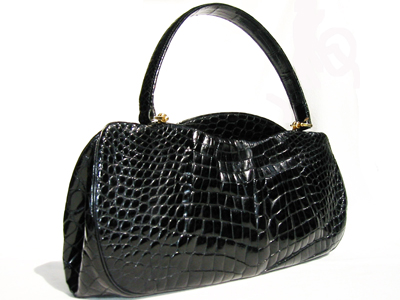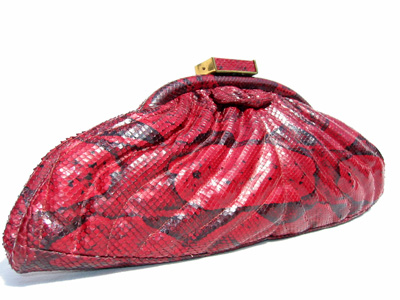Keeping your bags hydrated and using some general common sense is the key to their longevity! It is not difficult to keep your exotic skin bags and accessories in terrific condition so that they may continue to be passed down through generations. Animal skins, specifically exotic skins, need to be nourished on a regular basis in order to keep them soft and supple and to keep them from drying, cracking, flaking or splitting.
We condition and polish all of our items prior to sending them out to their new home. We also include care instructions with every purchase, however, should you have any questions after your purchase on caring for your items, please do not hesitate to contact us. Below, we have outlined some general guidelines to help you keep your "legacy" pieces in tip top shape!
ALLIGATOR/CROCODILE LEATHER
Alligator and crocodile leather, in particular, is one of the most beautiful and durable of the luxurious exotic leathers. Without proper care, the flexibility, durability and overall appearance of alligator leather will diminish drastically.  Under normal use and over time, some of the oils that tanners put into the leather will disappear. These oils and compounds must be replaced periodically in order to maintain the beauty and longevity of your exotic leather product.
Under normal use and over time, some of the oils that tanners put into the leather will disappear. These oils and compounds must be replaced periodically in order to maintain the beauty and longevity of your exotic leather product.
- NEVER use household chemicals to clean your exotic leather skins. Harsh products (like Pledge furniture polish, alcohol, or other solvents) can destroy the natural glazed protein finish on classic alligator finishes and can often remove any coloring or finish applied to skins. Over time the use of these products will leave your bag looking dull and worn. Use only products made for exotic skins, like BICK 4 Cleaner and Conditioner, which is our product of choice. This product will keep your bag properly hydrated and offers excellent water and stain resistant qualities.
- Clean your bags, then polish. It is important to understand that you can not clean exotic skins with polish, oils or creams...you will only seal in the dirt/dust. Your items need to be cleaned first, then can be further protected with a matching colored polish. We use Meltonian creams, because of their wide range of colors, but you can also use Kiwi products - both are Sara Lee Companies. We normally apply a small amount of cleaner/conditioner to our skins, buff off, and then as an extra step, follow with a treatment of the same color polish or cream.
- NEVER use nail polish or super glue on your bags. These products will produce the same reaction on exotic skin as they do on human skin, and will destroy your bag.
If your skins are excessively dry, flaky and brittle, this means they have dry-rotted (which happens when natural oils are not replaced into the skins over a long period of time, or they have been exposed to moisture/water). Unfortunately, and sadly, the item is probably beyond refurbishing, and your best bet is to retire it.
SNAKE & LIZARD SKINS
The variety of patterns, coloring and textures available with lizard and snake skins, have prompted many high-end designers to incorporate them into their fashion lines.
Although very durable exotic skins, they too, over time, will dry out, flake and/or lift if not given the proper oils necessary to keep them soft and supple. Snake and lizard skins are also exotic skins that will last decades if properly cared for with a regular scheduled cleaning with Bick 4 Leather Cleaner & Conditioner. 
Caring for your snake skin items is slightly different than other skins due to the more prominent, defined "scales." It is critical when treating your snake skin items, that treatment applications be applied in the direction of the scales. The proper direction can be determined by lightly running your hand along the skin. It will either be smooth (indicating the direction of the scales) or it will be rough or your hand will catch more easily (indicating that you are going against the natural "grain" of the scales). If you rub or apply any products against the natural "grain" of the scales, you will pull the scales up and give the skins an undesirable "flaking" appearance.
It is important to note that Python skins have large scaled areas on their skins that naturally lift slightly and this should not be mistaken for damage or dryness.
Finally, remember to always store your items in a protective, temperate place when not in use, lightly stuffed with tissue in your dust bag or box- dust and prolonged exposure to heat is the #1 culprit of dry skins!
